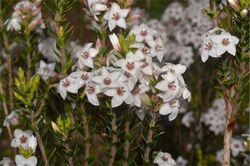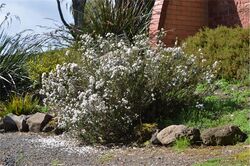Biology:Epacris barbata
| Epacris barbata | |
|---|---|

| |
| Scientific classification | |
| Kingdom: | Plantae |
| Clade: | Tracheophytes |
| Clade: | Angiosperms |
| Clade: | Eudicots |
| Clade: | Asterids |
| Order: | Ericales |
| Family: | Ericaceae |
| Genus: | Epacris |
| Species: | E. barbata
|
| Binomial name | |
| Epacris barbata Melville[1]
| |
Epacris barbata, commonly known as bearded heath,[2] is a species of flowering plant in the heath family Ericaceae and is endemic to a restricted area of Tasmania. It is an erect shrub with lance-shaped leaves and white, tube-shaped flowers with hairy sepals.
Description
Epacris barbata is an erect shrub that typically grows to a height of up to 2 m (6 ft 7 in) long and has many robust branches. The leaves are lance-shaped, 7–9.5 mm (0.28–0.37 in) long and 3–5 mm (0.12–0.20 in) wide on a petiole less than 1 mm (0.039 in) long. The leaves are sharply pointed and the edges curve downwards. The flowers are arranged singly in leaf axils near the tips of the branches, white and more or less sessile. The sepals are densely covered with soft hairs and the petals are joined at the base, forming a bell-shaped tube 4–5.5 mm (0.16–0.22 in) long with lobes 5–6.5 mm (0.20–0.26 in) long. The style is 5–6.5 mm (0.20–0.26 in) long and with the stamens, protrudes slightly beyond the petal tube. Flowering occurs in spring.[2][3]
Taxonomy and naming
Epacris barbata was first formally described in 1952 by Ronald Melville in the Kew Bulletin from specimens collected by Winifred Curtis at Coles Bay in 1946.[4][5] The specific epithet (barbata) means "bearded".[6]
Distribution and habitat
Bearded heath is restricted to the Freycinet Peninsula and nearby Schouten Island where it grows in heath and heathy woodland on granite.[2][3]
Conservation status
Epacris barbata is classified as "endangered" under the Australian Government Environment Protection and Biodiversity Conservation Act 1999 and the Tasmanian Government Threatened Species Protection Act 1995. The main threat to the species is dieback due to the fungus Phytophthora cinnamomi.[2][3]
References
- ↑ "Epacris barbata". Australian Plant Census. https://biodiversity.org.au/nsl/services/apc-format/display/63198.
- ↑ 2.0 2.1 2.2 2.3 "Approved Conservation Advice for Epacris barbata (Bearded Heath)". Australian Government Department of Agriculture, Water and the Environment. http://www.environment.gov.au/biodiversity/threatened/species/pubs/17625-conservation-advice.pdf.
- ↑ 3.0 3.1 3.2 "Epacris barbata - bearded heath". Tasmanian Government Department of Primary Industries, Parks, Water and the Environment. https://nre.tas.gov.au/Documents/Epacris-barbata.pdf.
- ↑ "Epacris barbata". APNI. https://id.biodiversity.org.au/instance/apni/469098. Retrieved 25 April 2022.
- ↑ Melville, Ronald (1952). "Two Allies of Epacris heteronema Lab.". Kew Bulletin 7 (2): 175–178. doi:10.2307/4109260. https://doi.org/10.2307/4109260. Retrieved 25 April 2022.
- ↑ Sharr, Francis Aubi; George, Alex (2019). Western Australian Plant Names and Their Meanings (3rd ed.). Kardinya, WA: Four Gables Press. p. 143. ISBN 9780958034180.
Wikidata ☰ Q15376285 entry
 |



